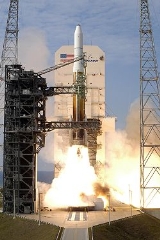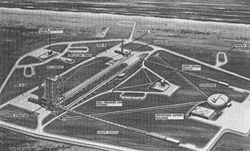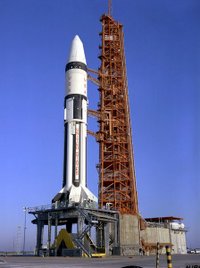
Cape Canaveral Air Force Station Launch Complex 37
Encyclopedia
Cape Canaveral Air Force Station
Cape Canaveral Air Force Station
Cape Canaveral Air Force Station is an installation of the United States Air Force Space Command's 45th Space Wing, headquartered at nearby Patrick Air Force Base. Located on Cape Canaveral in the state of Florida, CCAFS is the primary launch head of America's Eastern Range with four launch pads...
Space Launch Complex 37 (SLC-37), previously Launch Complex 37 (LC-37), is a launch complex on Cape Canaveral
Cape Canaveral
Cape Canaveral, from the Spanish Cabo Cañaveral, is a headland in Brevard County, Florida, United States, near the center of the state's Atlantic coast. Known as Cape Kennedy from 1963 to 1973, it lies east of Merritt Island, separated from it by the Banana River.It is part of a region known as the...
, Florida. Construction began in 1959 and the site was accepted by NASA
NASA
The National Aeronautics and Space Administration is the agency of the United States government that is responsible for the nation's civilian space program and for aeronautics and aerospace research...
to support the Saturn I program in 1963. The complex consists of two launch pads. LC-37A has never been used, but LC-37B launched unmanned Saturn I flights (1964 to 1965) and was modified and launched Saturn IB
Saturn IB
The Saturn IB was an American launch vehicle commissioned by the National Aeronautics and Space Administration for use in the Apollo program...
flights (1966 to 1968), including the first (unmanned) test of the Apollo Lunar Module
Apollo Lunar Module
The Apollo Lunar Module was the lander portion of the Apollo spacecraft built for the US Apollo program by Grumman to carry a crew of two from lunar orbit to the surface and back...
in space. It was deactivated in 1972. In 2001 it was modified as the launch site for Delta IV, a launch system operated by United Launch Alliance
United Launch Alliance
United Launch Alliance is a joint venture of Lockheed Martin and Boeing. ULA was formed in December 2006 by combining the teams at these companies which provide spacecraft launch services to the government of the United States. U.S...
.


SA-5 (Apollo)
SA-5 was the first launch of the Block II Saturn I rocket and was part of the Apollo Program.-Upgrades and objectives:The major changes that occurred on SA-5 were that for the first time the Saturn I would fly with two stages - the S-I first stage and the S-IV second stage. The second stage...
unmanned test of the Saturn I launch vehicle
Launch vehicle
In spaceflight, a launch vehicle or carrier rocket is a rocket used to carry a payload from the Earth's surface into outer space. A launch system includes the launch vehicle, the launch pad and other infrastructure....
. It was closed in 1968, following the unmanned Apollo flight Apollo 5
Apollo 5
Apollo 5 was the first unmanned flight of the Apollo Lunar Module, which would later carry astronauts to the lunar surface. It lifted off on January 22, 1968 with a Saturn IB rocket.-Objectives:...
, but re-opened in 2002 as a Delta IV launch site, and is in active use for that launch system.
The original layout of the launch complex featured one Mobile Service Structure which could be used to service or mate a rocket on either LC-37A or 37B, but not on both simultaneously. The Delta IV Mobile Service Tower is 330 ft (100.6 m) tall.
Saturn
All flights operated by NASA.| Date | Launch vehicle | Payload | Mission/function | Remarks |
|---|---|---|---|---|
| Jan. 29, 1964 | Saturn I | none | SA-5 SA-5 (Apollo) SA-5 was the first launch of the Block II Saturn I rocket and was part of the Apollo Program.-Upgrades and objectives:The major changes that occurred on SA-5 were that for the first time the Saturn I would fly with two stages - the S-I first stage and the S-IV second stage. The second stage... |
First live S-IV S-IV The S-IV was the second stage of the Saturn I, a rocket-powered launch vehicle used by NASA for early flights in the Apollo program.The S-IV was manufactured by the Douglas Aircraft Company and later modified by them to the S-IVB, a similar but distinct stage used on the Saturn IB and Saturn V... second stage |
| May 28, 1964 | Saturn I | BP-13 boilerplate CSM Apollo Command/Service Module The Command/Service Module was one of two spacecraft, along with the Lunar Module, used for the United States Apollo program which landed astronauts on the Moon. It was built for NASA by North American Aviation... |
A-101 (SA-6) | First boilerplate CSM |
| Sept. 18, 1964 | Saturn I | BP-15 boilerplate CSM | A-102 (SA-7) | |
| Feb. 16, 1965 | Saturn I | Pegasus A Pegasus satellite program The Pegasus satellite program was a series of three American satellites launched in 1965 to study the frequency of micrometeorite impacts on spacecraft... and BP-16 boilerplate CSM |
A-103 (SA-9) | Pegasus studied micrometeoroid Micrometeoroid A micrometeoroid is a tiny meteoroid; a small particle of rock in space, usually weighing less than a gram. A micrometeor or micrometeorite is such a particle that enters the Earth's atmosphere or falls to Earth.-Scientific interest:... impacts |
| May 25, 1965 | Saturn I | Pegasus B and BP-26 boilerplate CSM | A-104 (SA-8) | |
| July 30, 1965 | Saturn I | Pegasus C and BP-9A boilerplate CSM | A-105 (SA-10) | |
| July 5, 1966 | Saturn IB | none | AS-203 AS-203 AS-203 was an unmanned flight of the Saturn IB rocket on July 5, 1966. It carried no Apollo Command/Service Module spacecraft, as its purpose was to verify the design of the S-IVB rocket stage restart capability that would later be used in the Apollo program to boost astronauts from Earth orbit to... |
Test of S-IVB S-IVB The S-IVB was built by the Douglas Aircraft Company and served as the third stage on the Saturn V and second stage on the Saturn IB. It had one J-2 engine... ; informally called Apollo 2 |
| Jan. 22, 1968 | Saturn IB | LM-1 | Apollo 5 Apollo 5 Apollo 5 was the first unmanned flight of the Apollo Lunar Module, which would later carry astronauts to the lunar surface. It lifted off on January 22, 1968 with a Saturn IB rocket.-Objectives:... |
Test of the first lunar module |
See also
- List of spaceflights by year
- List of Cape Canaveral and Merritt Island launch sites
- Project ApolloProject ApolloThe Apollo program was the spaceflight effort carried out by the United States' National Aeronautics and Space Administration , that landed the first humans on Earth's Moon. Conceived during the Presidency of Dwight D. Eisenhower, Apollo began in earnest after President John F...
- Cape Canaveral Air Force Station Launch Complex 34Cape Canaveral Air Force Station Launch Complex 34Cape Canaveral Air Force Station Launch Complex 34 is a launch site on Cape Canaveral, Florida. LC-34 and its twin to the north, LC-37, were used by NASA as part of the Apollo Program to launch Saturn I and IB rockets from 1961 through 1968...

